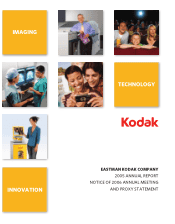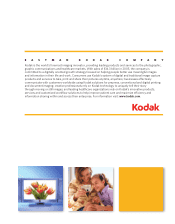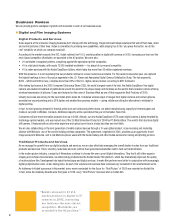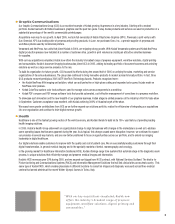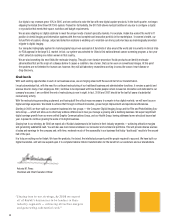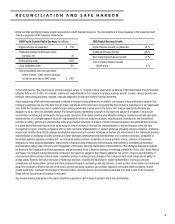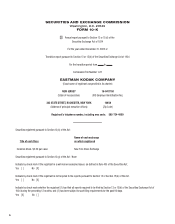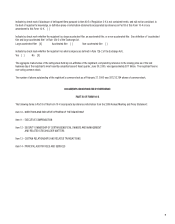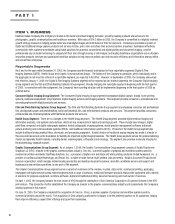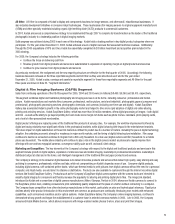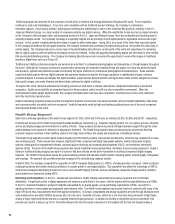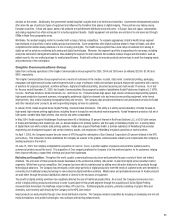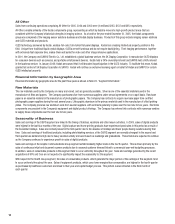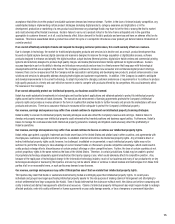Kodak 2005 Annual Report Download - page 11
Download and view the complete annual report
Please find page 11 of the 2005 Kodak annual report below. You can navigate through the pages in the report by either clicking on the pages listed below, or by using the keyword search tool below to find specific information within the annual report.9
All Other: All Other is composed of Kodak’s display and components business for image sensors, and other small, miscellaneous businesses. It
also includes development initiatives in consumer inkjet technologies. These businesses offer imaging sensors to original equipment manufacturers
(OEMs) and other specialty materials including organic light emitting diode (OLED) products to commercial customers.
In 2003, Kodak announced a comprehensive strategy to be implemented through 2007 to complete its transformation as the leader of the traditional
photographic industry to a leadership position in digital imaging markets.
Solid progress was achieved during 2005 in each area of this strategy. Kodak holds a leading position in key digital product categories where we
participate. For the year ended December 31, 2005, Kodak achieved a level of digital revenues that exceeded traditional revenues. Additionally,
through the 2005 acquisitions of KPG and Creo, Kodak has essentially completed its $3 billion investment and acquisition plan included in the
2003 strategy.
For 2006, the Company’s strategy includes the following priorities:
• Continue the focus on delivering cash fl ow
• Revenue growth from digital products and services is subordinated to expansion of operating margin on digital products and services
• Continue to grow revenue from digital products and services
As previously mentioned, the realignment and the new reporting structure are effective for the fi rst quarter of 2006. Accordingly, the following
business discussion is based on the three reportable segments and All Other as they were structured as of and for the year ended
December 31, 2005. Kodak’s sales, earnings and assets by reportable segment for these three reportable segments and All Other for the past
three years are shown in Note 23, “Segment Information.”
Digital & Film Imaging Systems (D&FIS) Segment
Sales from continuing operations of the D&FIS segment for 2005, 2004 and 2003 were (in millions) $8,460, $9,366 and $9,415, respectively.
This segment combines digital and traditional photography and imaging services in all its forms, including consumer, professional and motion
picture. Kodak manufactures and markets fi lms (consumer, professional, motion picture, aerial and industrial), photographic papers (consumer and
professional), photographic processing services, photographic chemicals, and cameras (including one-time-use and digital). Kodak EasyShare
Gallery has accelerated Kodak’s growth in the online photography market and helped to drive more rapid adoption of digital and online sharing,
printing and archiving services. Kodak EasyShare Gallery, which has more than 30 million members, offers digital processing of images - both digital
and fi lm - as well as the ability to go beyond printing 4x6 and create more margin rich items such as photo frames, calendars, photo playing cards,
and a host of other personalized merchandise.
Digital product offerings are replacing some of the traditional fi lm products at varying rates. For example, the workfl ow improvements offered by
digital are having relatively more signifi cant effects in the professional markets, while digital is having little impact in the entertainment markets.
The future impact of digital substitution on these fi lm markets is diffi cult to predict due to a number of factors, including the pace of digital technology
adoption, the underlying economic strength or weakness in major world markets, and the timing of digital infrastructure installation. Film usage
continues to decline as consumers continue to migrate from a fi lm-only household, to a dual-use (digital camera and fi lm) household, to a mobile
phone use household. The mobile phone industry will continue to play a role in the digital camera market as phonecams rapidly improve their
offerings with one and two megapixel cameras, convergence ability such as wifi , and small, sleek design.
Marketing and Competition: The key elements of the Company’s strategy with respect to the digital and traditional products and services in this
segment include growth in digital capture, expansion of online services and mobile imaging, leadership in professional lab solutions, leadership in
distributed output at retail and in the home, and intelligent management of the traditional fi lm and paper products and services.
The Company’s strategy in its consumer digital business is to deliver innovative products and services that deliver high quality, easy sharing and easy
archiving to consumers, professionals, retailers and labs, while not compromising on Kodak’s legendary ease of use. Consumer digital products,
including digital cameras, self-contained printer docks, which use thermal media to print pictures from digital cameras without the need for a personal
computer, and inkjet media, are sold direct to retailers or distributors. Products are also available to customers through the Internet via online digital
services like Kodak EasyShare Gallery. Products such as the Company’s EasyShare digital camera system with the camera docks are intended to
simplify digital imaging for consumers and thereby increase the popularity for sharing and printing digital photo fi les. The ImageLink standard,
introduced by Kodak and a consortium of digital camera manufacturers (Nikon, Olympus, Pentax) in 2004, allows non-Kodak cameras to connect to
the EasyShare printer dock, enabling consumers to print outstanding quality snapshots at the press of a button without connecting to a computer.
The Company faces competition from other electronics manufacturers in this market, particularly on price and technological advances. Rapid price
declines shortly after product introduction in this environment are common, as producers are continually introducing new models with enhanced
capabilities, such as improved resolution and/or optical systems. Kodak EasyShare Gallery, the Company’s online imaging business, continues to
demonstrate strong growth and began the establishment of a customer base in selected overseas markets in 2003. Late in 2003, the Company
announced Kodak Mobile Service, which allows consumers with image-enabled mobile phones to store, share and print their images.

